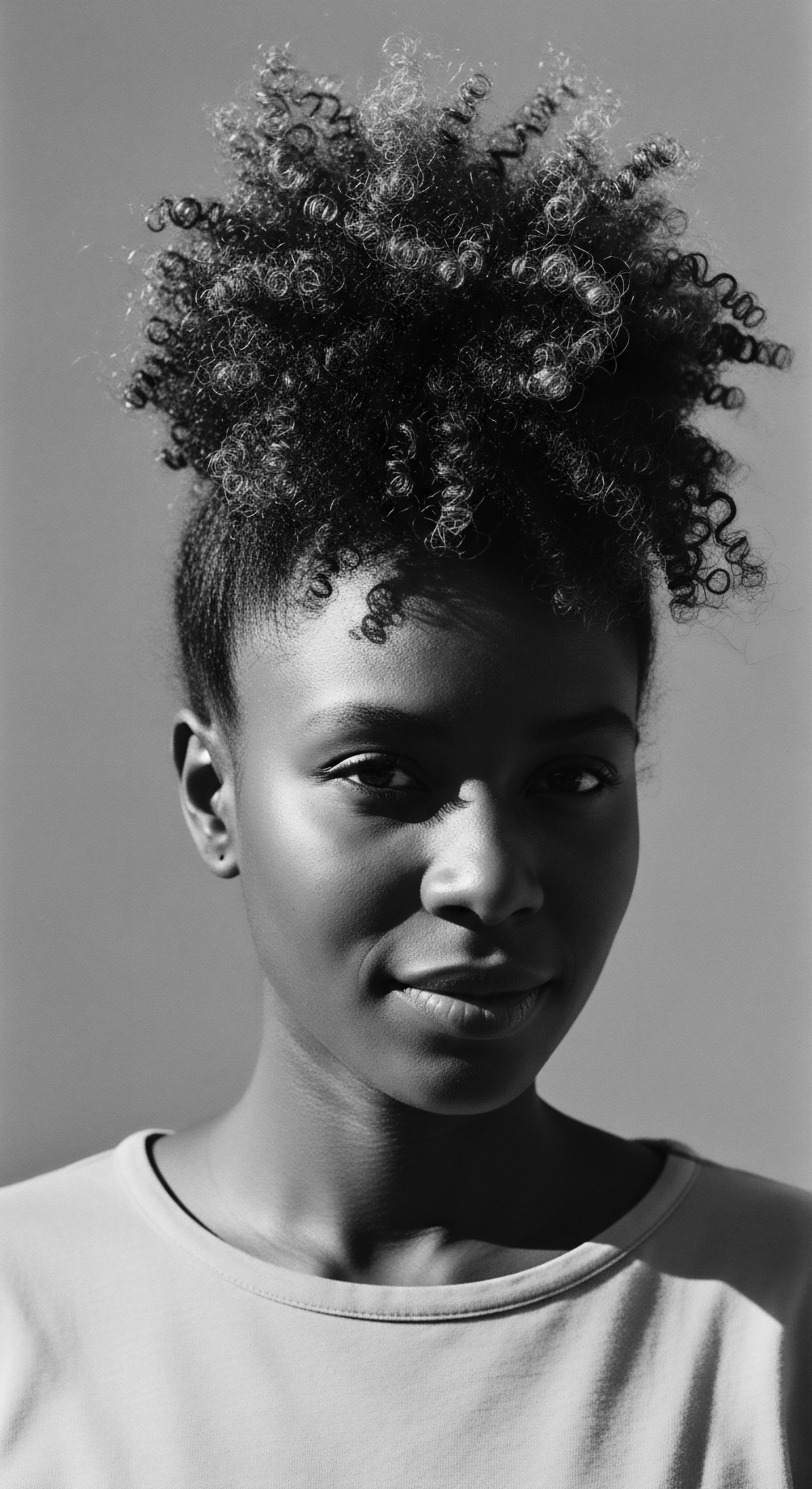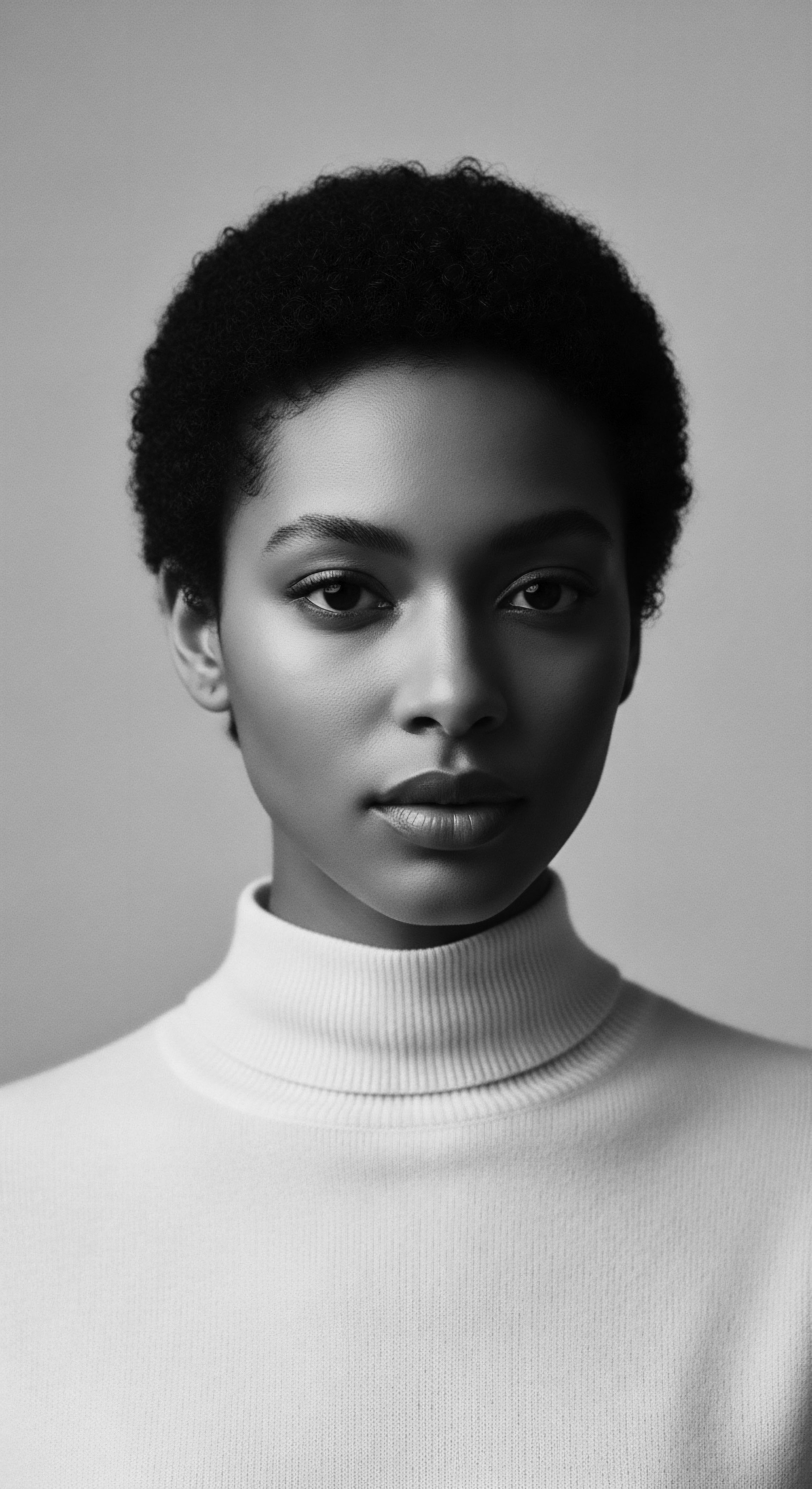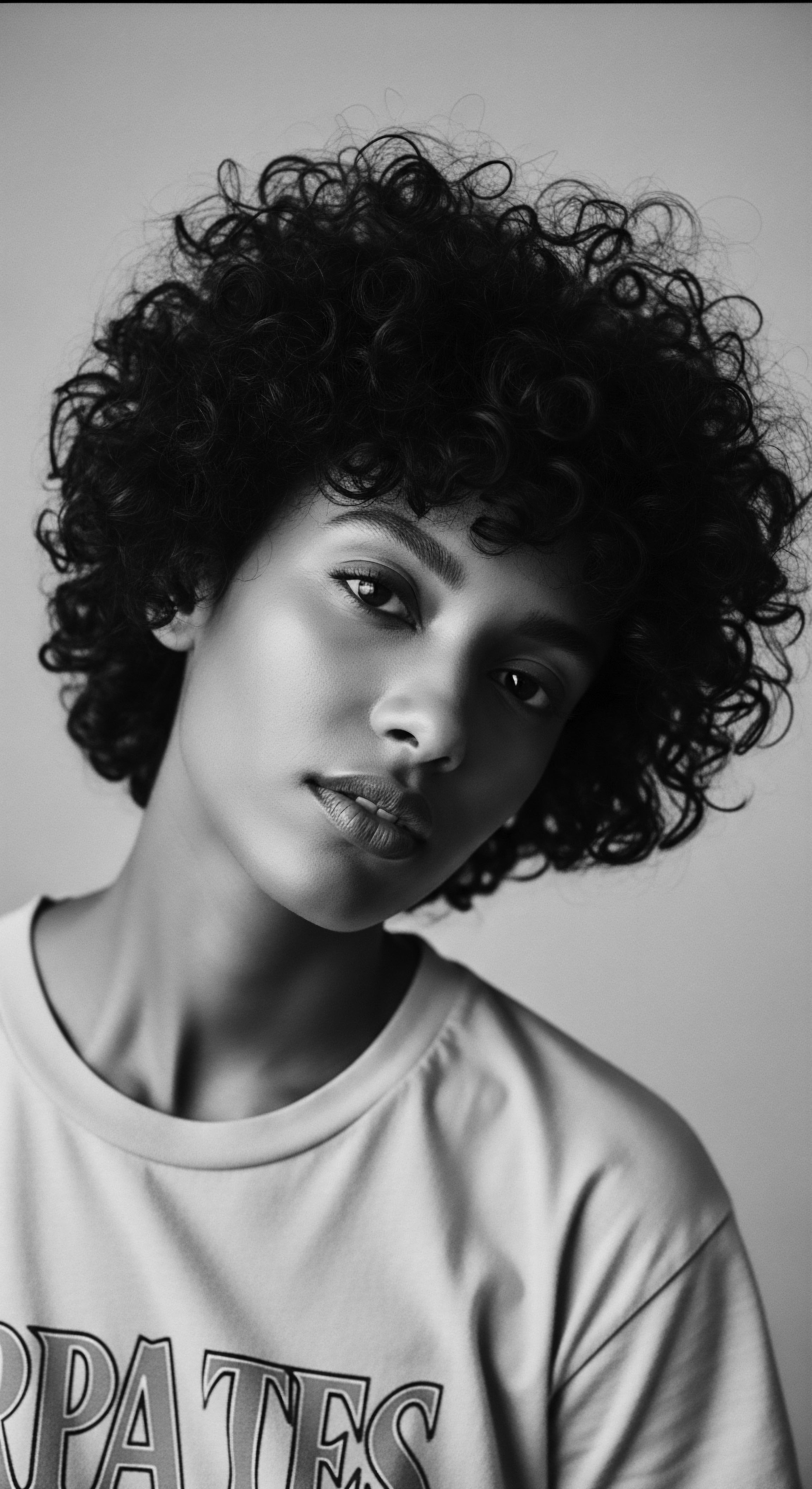
Roots
Consider, for a moment, the very strands that spring forth from your scalp. They are not simply filaments of protein; they hold stories, whispered across generations, etched into their very coiled form. To truly grasp ancient textured hair moisture practices, we must first look to the Earth from which these rituals sprang, understanding the biological blueprint, yes, but more significantly, the cultural landscape that cradled such care.
We are not merely speaking of hydration; we are tracing a lineage of reverence, a testament to ingenuity born of necessity and tradition. The quest to keep these crowns supple and vibrant reaches back to epochs when our ancestors, facing varied climates and environmental demands, intuitively understood the delicate needs of their hair.
Ancient textured hair moisture practices unveil a heritage of intuitive care, deeply connected to the Earth’s offerings and ancestral wisdom.
The unique geometry of textured hair, with its often elliptical cross-section and spiraling growth pattern, naturally exposes more cuticle layers, allowing moisture to escape with greater ease. This structural reality, observed perhaps not through microscopes but through daily lived experience, dictated the very principles of ancient maintenance. Our forebears, whether in the sun-drenched savannas or humid rainforests, recognized this inherent predisposition to dryness and adapted their practices accordingly. They understood the art of sealing in precious water long before the scientific tenets of occlusion were articulated.

The Sacred Strand Its Design
To speak of textured hair is to speak of a remarkable design, a helix that defies simplistic categorization. Each curl, coil, and wave contributes to a collective strength, yet also presents points of vulnerability where the cuticle, the hair’s protective outer layer, lifts, allowing the core’s hydration to dissipate. This characteristic, which modern trichology has detailed, was surely experienced by our ancestors as a daily reality. The very air, the dust, the sun’s persistent caress—all sought to strip away the hair’s vital fluid.
- Cuticle Integrity ❉ Maintaining the smoothness of the cuticle for moisture retention and protection.
- Natural Oils ❉ The scalp’s inherent sebum, often struggling to travel the length of a coiled strand.
- Environmental Factors ❉ Sun, wind, and dry air presenting constant challenges to hair’s hydration.

How Did Ancestors Interpret Hair’s Biological Needs?
Our ancestors, without the benefit of molecular biology, possessed a profound intuitive comprehension of their hair’s requirements. They learned from observation, from the resilience of plants, and from the wisdom passed down through oral traditions. They saw how certain botanical extracts provided slip, how animal fats offered a protective barrier, and how water, in its purest form, was the foundational element.
This was practical science, honed over millennia, a knowledge woven into the rhythm of daily life. The practices were not arbitrary; they directly responded to the hair’s biological tendencies and environmental pressures.
Consider, too, the role of Melanin within textured hair. While primarily responsible for pigmentation, melanin’s presence and distribution also influence structural characteristics. The very density and distribution of pigment granules can impact the hair shaft’s thermal and oxidative stress response.
Ancient moisture practices, by applying protective layers, likely mitigated some of these environmental impacts, even if the precise scientific mechanism was not yet known. The understanding was holistic, treating the hair as a living extension of the body and spirit.

Ritual
The ancient practices for moisturizing textured hair transcend mere technique; they formed rituals, deeply embedded in communal life and individual identity. These were not quick applications but deliberate acts, often shared amongst family and community, transforming routine care into moments of connection and instruction. The hands that tended to hair were often those of mothers, aunts, or respected elders, passing along not only physical movements but also the stories, songs, and wisdom associated with these heritage practices.

What Sustained Hair’s Fluidity?
The sustenance of hair’s fluidity, its very pliability and luster, was a persistent concern. Ancient communities employed a range of materials, primarily derived from nature, to achieve this. These were often fatty substances, plant extracts, and natural emollients. The selection was pragmatic, born from what the immediate environment provided, yet also discerning, identifying compounds that visibly softened and protected the hair.
- Plant Oils ❉ Ingredients like Shea Butter (from the karité tree), Palm Oil, Argan Oil, and Coconut Oil were widely used across different regions, providing both moisture and a protective seal.
- Animal Fats ❉ In some colder or arid climates, rendered animal fats might have been applied, offering a dense barrier against moisture loss and environmental harshness.
- Botanical Mucilages ❉ Extracts from plants like Okra, Aloe Vera, or certain barks provided slippery, hydrating gels that could detangle and condition.
One compelling example of a deeply integrated ancient moisture practice comes from the Himba Women of Namibia. Their daily ritual involves applying ‘otjize’, a vibrant reddish-orange paste. This mixture, a blend of butterfat, ochre pigment, and aromatic resin, functions as a multifaceted care system for both skin and hair. It cleanses, moisturizes, protects from the harsh desert sun, and acts as a cultural marker of beauty and identity (Jacobsohn, 1990).
The butterfat within the otjize is a powerful occlusive, preventing water evaporation from the hair shaft and scalp in an extremely arid environment. This is not simply a cosmetic application; it is a profound testament to ancestral knowledge, where available resources were meticulously combined to address specific environmental challenges and cultural expressions.
| Ancient Practice Source Karité Tree (Shea) |
| Traditional Application Warm butter rubbed onto strands to seal hydration. |
| Modern Cosmetic Equivalent Shea butter in leave-in conditioners and hair masks. |
| Ancient Practice Source Aloe Vera Leaf |
| Traditional Application Fresh gel applied for conditioning and soothing. |
| Modern Cosmetic Equivalent Aloe vera extract in hydrating gels and detanglers. |
| Ancient Practice Source Various Clays |
| Traditional Application Mixed with water or oils for cleansing and drawing impurities. |
| Modern Cosmetic Equivalent Clay masks for scalp detoxification and clarifying. |
| Ancient Practice Source These ancient resources provided the foundation for effective textured hair care, their benefits echoing in today's formulations. |

How Were Hair Practices Passed Between Generations?
The transmission of these practices was largely oral and observational, a true living library of care. Children learned by watching, by participating, and by being the recipients of these tender ministrations. The process of hair braiding, for instance, often involved applying oils and butters, a rhythmic ritual that fostered bonding and preserved ancestral techniques. This pedagogical approach, deeply rooted in cultural customs, ensured the continuity of specific moisturizing recipes and methods, adapting subtly over time but maintaining their core principles.
The very act of hair care was a form of communal storytelling. As hands worked through coils, narratives of resilience, of beauty standards, and of lineage were shared. This intimate setting was the classroom, the parlor, and the council all at once, affirming hair’s role not only as a biological component but as a powerful cultural artifact.

Relay
The relay of ancient textured hair moisture practices into our contemporary understanding involves more than simple preservation; it requires a deep analytical lens, connecting historical ingenuity with modern scientific validation. We examine how the ancestral wisdom, once dismissed by colonial narratives, now finds validation in trichological research and holistic wellness philosophies. This is where the historian’s eye meets the scientist’s precision, all grounded in reverence for cultural heritage.

Do Ancient Methods Align With Modern Hair Science?
Many ancient moisture methods surprisingly align with current understanding of hair physiology. The use of oils and butters, for example, directly addresses the need for occlusion in textured hair. Because its coiled structure often impedes the natural flow of sebum down the hair shaft, external lipids become necessary to coat the strand, reducing trans-epidermal water loss.
Ancient practices intuitively understood this protective layer was critical. They were, in essence, employing a sophisticated understanding of hygroscopy and lipid barriers.
Furthermore, the practice of applying humectant-rich plant extracts, like aloe vera, speaks to an understanding of moisture attraction. These plants contain compounds that draw water from the environment into the hair, or help to bind water already present. Our ancestors, through trial and error, discerned which botanical elements offered this plumping, softening effect. This empirical knowledge, accumulated over generations, forms a foundation of what we now classify as evidence-based practice.
The efficacy of many ancient textured hair moisture practices gains scientific validation through modern understanding of hair structure and ingredient function.
The very rhythm of ancient care—often involving less frequent cleansing and more consistent conditioning—also finds resonance in contemporary recommendations for textured hair. Over-shampooing can strip hair of its natural oils, exacerbating dryness. Ancient rhythms, dictated by resource availability and deep understanding of the hair’s needs, often prioritized re-moisturizing and gentle care over harsh cleansing.

What Role Did Traditional Fermentation Play?
Beyond simple extraction, some ancient cultures employed fermentation processes to enhance the properties of their hair care ingredients. For example, fermented rice water, a practice often linked to the Yao women of China, has been traditionally used not only for hair growth but also for its conditioning and detangling benefits. While the practice is not exclusive to highly textured hair, its principles are relevant. Fermentation can break down complex molecules, making nutrients more bioavailable, and can create new compounds, such as lactic acid, which might act as humectants or pH balancers.
The traditional soaking and mashing of certain barks or roots to create mucilaginous washes also hints at a form of controlled degradation that released beneficial compounds. These were sophisticated, if unwritten, chemical processes, yielding concoctions that were far more than simple water mixtures. The ingenuity lay in observing how these altered substances interacted with the hair, leading to their continued adoption.
The ancestral diet, too, played a silent but significant role in hair hydration. Communities subsisting on diets rich in essential fatty acids, vitamins, and minerals—often derived from diverse plant sources and lean proteins—supported healthy hair growth from within. Internal hydration and nutrition formed the bedrock upon which external moisture practices were built, a holistic approach that modern wellness advocates champion today. This internal-external synergy for hair vitality reflects a complete understanding of wellbeing passed down through the generations.
| Traditional Practice Oiling hair regularly with plant butters |
| Ancestral Observation Hair felt softer, looked shinier, broke less. |
| Scientific Explanation Lipids form an occlusive layer, reducing water evaporation from the cortex. |
| Traditional Practice Using plant-based washes (e.g. mucilaginous plants) |
| Ancestral Observation Hair was easier to detangle, felt conditioned. |
| Scientific Explanation Polysaccharides and proteins provide slip and absorb water. |
| Traditional Practice Protective styling with added oils/butters |
| Ancestral Observation Hair retained length, seemed to grow. |
| Scientific Explanation Reduced manipulation and environmental exposure minimizes mechanical damage and moisture loss. |
| Traditional Practice The enduring power of ancient moisture practices is validated by their physiological efficacy and cultural continuity. |
Moreover, the communal aspect of ancient hair care, observed in many societies, offered a social dimension to moisture practices. Shared knowledge, collective labor in preparing ingredients, and the nurturing touch within a community contributed to well-being that transcended mere physical health. This emotional and spiritual nourishment, subtly woven into the acts of moisturizing and styling, undeniably influenced the overall vitality of the hair itself. A relaxed, confident individual, feeling supported by their community, often exhibits greater physical health, including the health of their hair.

Reflection
In traversing the pathways of ancient textured hair moisture practices, we unveil more than historical footnotes; we witness a living legacy. These ancestral rituals, steeped in Earth’s bounty and communal wisdom, are not relics confined to distant pasts. They are profound meditations on care, resilience, and identity that continue to shape our interaction with textured hair today. Each application of an oil, each gentle detangling, echoes the hands of those who came before us, connecting us to a heritage of profound self-understanding and deep reverence for our coils and curls.
The ‘Soul of a Strand’ ethos finds its truest expression in this historical continuity. It is the recognition that our hair carries the memory of adaptation, the beauty of cultural expression, and the enduring strength of traditions forged in challenging environments. The moisture practices of antiquity demonstrate an innate, sophisticated understanding of what textured hair requires to flourish—a blend of protective layers, intrinsic hydration, and a gentle, consistent touch.
This wisdom, passed through generations, invites us to reconsider our relationship with our own hair, not as a challenge to be conquered, but as a lineage to be honored, a conduit to the past, and a declaration for the future. Our care practices, then, become a quiet, potent act of remembrance, ensuring these vital practices, born of necessity and beauty, endure.

References
- Jacobsohn, Margaret. The Himba of Namibia. Southern African Documentation and Information Centre, 1990.
- Bade, D. Anatomy and Physiology of the Hair. Springer, 2012.
- Robbins, Clarence R. Chemical and Physical Behavior of Human Hair. 5th ed. Springer, 2012.
- Goldsmith, Lowell A. Physiology, Biochemistry, and Molecular Biology of the Skin. 3rd ed. Oxford University Press, 2011.
- Dreal, R. African Traditional Hair Care and Practices. Cultural Publications, 2005.
- Kouakou, Yao K. Ethnobotany of African Hair Practices ❉ A Study of West African Botanicals. University of Ghana Press, 2018.
- Cheatham, Marcus. Hair and Humanity ❉ A Cultural History. University of California Press, 2015.
